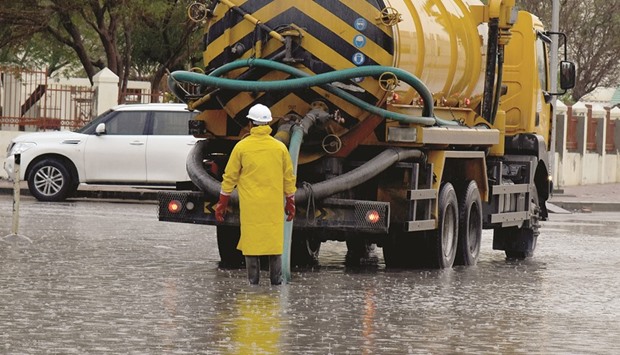We’re not really used to seeing so much cloud over Qatar. In fact, the last two weeks have been strangely unsettled, particularly between March 7 and 9, when there was also a lot of rain.
The grey weather that shrouded Qatar throughout this period was the tail end of a band of cloud and rain which stretched all the way from the Caspian Sea, just to the north of Iran. As the centre of circulation spun over the water, the trailing leg of the cloud continued to dangle across us. The heat of the Arabian Peninsula gave extra energy to the weather system, encouraging huge thunderstorms to develop. Some of these storms were very intense and in Doha the winds gusted as high as 70 kilometres per hour (43 mph). In those three days, a total of 21mm (0.8 inches) of rain was reported at the airport.
Most of Doha’s rain during this period fell on March 9. This was the day that the region saw the most intense thunderstorms, which also affected the UAE, eastern Saudi Arabia and Oman. Like Doha, many places across the region saw heavy rain that gave large areas of standing water, making some roads difficult to navigate. But whilst you may have thought the rain was heavy in Doha, in the UAE, it was something else.
At 11:30 in the morning of March 9, a severe thunderstorm rolled across Abu Dhabi. This storm battered the city with winds of 126 kilometres per hour (78 miles per hour). The winds tore down carports, fences and advertising hoardings, and anything that wasn’t tied down was tossed into the air. The debris that was picked up by the winds was thrown through the air like missiles, slamming into the side of buildings. A video on social media showed people running for cover as an object smashed into large glass doors, shattering them instantly.
Abu Dhabi and Dubai reported a similar amount of rain to Doha, but the rain wasn’t uniform across the Emirates. One region near Al Ain is reported to have received an incredible 294mm (nearly one foot) of rain during the storms. In some areas, people were seen on the roofs of their cars, waiting to be rescued, while elsewhere cars were seen floating down the street. One foolhardy man was even videoed wakeboarding through the flooded streets in a dishdash.
The rains were so heavy that they submerged part of the main highway between Abu Dhabi and Dubai. The police broke through crash barrier in the middle of the road to allow people to turn around and escape the flood water, but it wasn’t a quick process. One man said he got stuck at around 9:30am, and eventually arrived home 13 hours later.
As the storms moved east, the people in the UAE breathed a sigh of relief, but the storm hadn’t quite finished yet. After causing chaos in the Arabian Peninsula, the severe weather then tracked across the Gulf of Oman, into Iran and Pakistan.
Pakistan, Afghanistan and India were all struck by thunderstorms. In India, the storms brought rain, lightning and hail. Hail is one of the most devastating types of weather that there is for crops, it can completely flatten and destroy the plants in a field in a matter of minutes. The key wheat producing states of Punjab, Haryana, Rajasthan and Uttar Pradesh were all hit by hail and torrential rain, triggering floods and flattening crops.
Further north the storms brought heavy snow. This prompted the Indian Snow and Avalanche Study Establishment to issue an avalanche warning, warning people not to venture out in avalanche-prone areas.
However, whilst India was struggling with the storms, in Pakistan the situation was far worse. The torrential rain first hit Balochistan in the southwest of the country. It caused significant flood damage, and then quickly spread northwards. The storms remained intense, with Islamabad reporting 70mm of rain in just one day, which is nearly the average for the entire month of March.
Just to the east of Islamabad, Murree recorded approximately 175mm (7 inches) in the three days that the storms raged. Murree is a mountainous area, where such a large amount of rain in such a short amount of time would always cause major problems. The excessive amounts of rain would hurtle down the sides of the mountains, triggering flash floods.
In the Orakzai Agency, one of the federally administered tribal areas near Afghanistan, the rains were so heavy that they even triggered the collapse of a coalmine. A total of 26 miners were pulled to safety, but eight others lost their lives.
Finally, as the storms tried to cross the Himalayas, they began to lose their intensity and peter out. The majority of the flood water has now receded and things are returning to normal. However, for many people from Abu Dhabi to Islamabad, such intense storms won’t be forgotten for a long time to come.

UNUSUAL: Scenes on March 9, after the rain. The grey weather that shrouded Qatar throughout this period was the tail end of a band of cloud and rain which stretched all the way from the Caspian Sea, just to the north of Iran.
